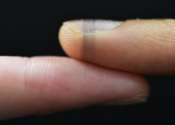Hair is a protein filament that grows through the epidermis from follicles deep within the dermis. The fine, soft hair found on many nonhuman mammals is typically called fur; wool is the characteristically curly hair found on sheep and goats. Found exclusively in mammals, hair is one of the defining characteristics of the mammalian class. Although other non-mammals, especially insects, show filamentous outgrowths, these are not considered "hair" in the scientific sense. So-called "hairs" (trichomes) are also found on plants. The projections on arthropods such as insects and spiders are actually insect bristles, composed of a polysaccharide called chitin. There are varieties of cats, dogs, and mice bred to have little or no visible fur. In some species, hair is absent at certain stages of life. The main component of hair fiber is keratin.
The hair can be divided into three parts length-wise, (1) the bulb, a swelling at the base which originates from the dermis, (2) the root, which is the hair lying beneath the skin surface, and (3) the shaft, which is the hair above the skin surface. In cross-section, there are also three parts, (1) the medulla, an area in the core which contains loose cells and airspaces (2) the cortex, which contains densely packed keratin and (3) the cuticle, which is a single layer of cells arranged like roof shingles.









